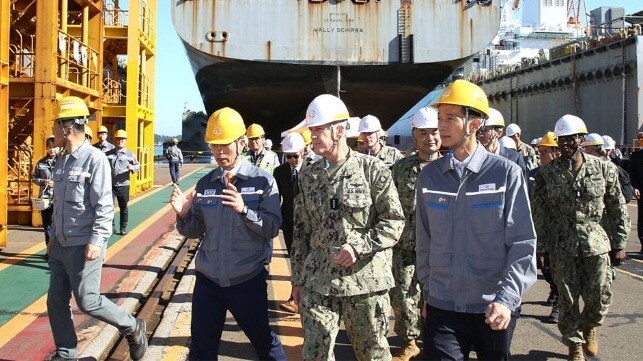Hanwha Ocean Courts U.S. Navy for Work in Korea and Philadelphia

South Korean shipbuilder Hanwha Ocean is continuing its efforts to build its relationship with the U.S. Navy as it looks to grow the acquired Daewoo Shipbuilding and Marine Engineering (DSME) operation as well as its plans to buy Philly Shipyard in the United States. Leveraging its expertise in military systems and electronics was one of the strategies Hanwha outlined when it purchased the controlling interest of the shipyard group.
The latest move to expand its relationship with the commanders of the U.S. Navy came on October 24 when Admiral Steve Koehler, Commander of the U.S. Pacific Fleet, visited Hanwha Ocean’s Geoje plant. At the end of September, U.S. Navy NAVSEA (Naval Sea Systems Command) Rear Admiral Thomas Anderson and Rear Admiral William Green also toured the R&D facilities run by Hanwha. All of this followed a tour in February 2024 for U.S. Secretary of the Navy Carlos Del Toro.
Hanwha Ocean became the first South Korean shipyard to undertake a repair and maintenance assignment under the U.S. Military Sealift Command Maintenance, Repair, and Overhaul program. The shipyard was certified to bid on projects in August and quickly won the assignment for the USNS Wally Schirra, a Lewis and Clark-class dry cargo ship, that arrived at the Geoje shipyard at the beginning of September. Hanwha Ocean reports it expects to complete the assignment in January after four months of work.
Hanwha Vice Chairman Kim Dong-kwan highlighted to Admiral Koehler that Hanwha Ocean is increasing its understanding of the maintenance management system for U.S. Navy vessels through the Wally Schirra project. He was shown the work underway on the vessel in the Korean dry dock. The company promised to optimize its supply chain for key equipment and materials to ensure the successful performance of future U.S. Navy vessel MRO projects.
They also provided a tour of the submarine construction area, merchant ship and marine plant construction area, and digital technology-based production facilities. During the meeting, they discussed the possibility of future maintenance business for the U.S. Military Sealift Command ships deployed in the Indo-Pacific region.
Hanwha Ocean highlights that it looks to play an increasing role within the U.S. Department of Defense strategy that calls for establishing maintenance hubs in Asia including in South Korea and Japan. The U.S. Military Sealift Command has also sent ships for repairs in recent years at shipyards in India.
Last month the company provided a tour of its Siheung R&D Campus which opened in 2018 to highlight its technological capabilities. Rear Admirals Anderson and Green along with U.S. Embassy personnel were shown the R&D facilities, including the Land Based Test Site, common tank, towing tank, and model-making room as well as the tests underway for eco-friendly fuel technologies for decarbonization, such as commercial-grade fuel cells, lithium-ion batteries, new-concept batteries, shaft generators, and ammonia propulsion. They reported the U.S. Navy was especially interested in Hanwha’s work with a lithium-ion energy storage system (ESS) for submarines developed by Hanwha Aerospace.
Hanwha Ocean announced in June that it agreed to acquire Philly Shipyard and the company hopes to close the deal possibly by the end of 2024 pending regulatory approval. In public statements, they have said they would look to expand the operation and target more U.S. Navy work. Currently, the yard is building ships for MARAD and commercial vessels.
Executives for the Philly operation have said the plan would be to provide capacity to the U.S. Navy both for shipbuilding and repair operations. They have said this might begin with support and specialized ships but indicated they would have the capabilities to build warships or modules.
Navy Secretary Del Toro has made statements supporting Hanwha Ocean’s efforts as part of the Maritime Statecraft strategy. He called Hanwha’s agreement to acquire Philly Shipyard a “game-changing milestone” and encouraged the South Korean shipyards to make investments to support the needs of the U.S. Navy.
No comments:
Post a Comment